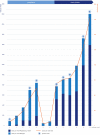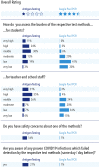Results of WICOVIR Gargle Pool PCR Testing in German Schools Based on the First 100,000 Tests
- PMID: 34778127
- PMCID: PMC8581236
- DOI: 10.3389/fped.2021.721518
Results of WICOVIR Gargle Pool PCR Testing in German Schools Based on the First 100,000 Tests
Abstract
Background: Opening schools and keeping children safe from SARS-CoV-2 infections at the same time is urgently needed to protect children from direct and indirect consequences of the COVID-19 pandemic. To achieve this goal, a safe, efficient, and cost-effective SARS-CoV-2 testing system for schools in addition to standard hygiene measures is necessary. Methods: We implemented the screening WICOVIR concept for schools in the southeast of Germany, which is based on gargling at home, pooling of samples in schools, and assessment of SARS-CoV-2 by pool rRT-PCR, performed decentralized in numerous participating laboratories. Depooling was performed if pools were positive, and results were transmitted with software specifically developed for the project within a day. Here, we report the results after the first 13 weeks in the project. Findings: We developed and implemented the proof-of-concept test system within a pilot phase of 7 weeks based on almost 17,000 participants. After 6 weeks in the main phase of the project, we performed >100,000 tests in total, analyzed in 7,896 pools, identifying 19 cases in >100 participating schools. On average, positive children showed an individual CT value of 31 when identified in the pools. Up to 30 samples were pooled (mean 13) in general, based on school classes and attached school staff. All three participating laboratories detected positive samples reliably with their previously established rRT-PCR standard protocols. When self-administered antigen tests were performed concomitantly in positive cases, only one of these eight tests was positive, and when antigen tests performed after positive pool rRT-PCR results were already known were included, 3 out of 11 truly positive tests were also identified by antigen testing. After 3 weeks of repetitive WICOVIR testing twice weekly, the detection rate of positive children in that cohort decreased significantly from 0.042 to 0.012 (p = 0.008). Interpretation: Repeated gargle pool rRT-PCR testing can be implemented quickly in schools. It is an effective, valid, and well-received test system for schools, superior to antigen tests in sensitivity, acceptance, and costs.
Keywords: COVID-19; Germany; PCR; children; gargle; pandemic; pooling; schools.
Copyright © 2021 Kheiroddin, Schöberl, Althammer, Cibali, Würfel, Wein, Kulawik, Buntrock-Döpke, Weigl, Gran, Gründl, Langguth, Lampl, Judex, Niggel, Pagel, Schratzenstaller, Schneider-Brachert, Gastiger, Bodenschatz, Konrad, Levchuk, Roth, Schöner, Schneebauer, Rohrmanstorfer, Dekens, Brandstetter, Zuber, Wallerstorfer, Burkovski, Ambrosch, Wagner and Kabesch.
Conflict of interest statement
TWa has invested in a company that performs PCR pool tests for companies. RR, FS, and DW are employed by NOVOGENIA, a commercial PCR test laboratory. JN and PP are employed by Maganamed GmbH, a commercial software company. DATEV eG is a software company which provides a non-profit test center for the project. The remaining authors declare that the research was conducted in the absence of any commercial or financial relationships that could be construed as a potential conflict of interest.
Figures





References
LinkOut - more resources
Full Text Sources
Miscellaneous

